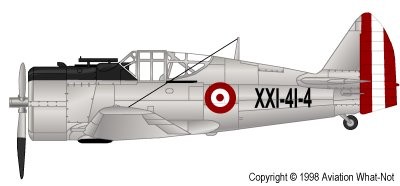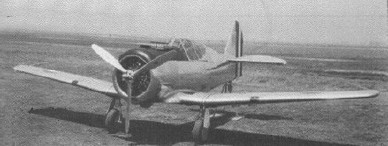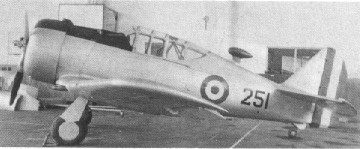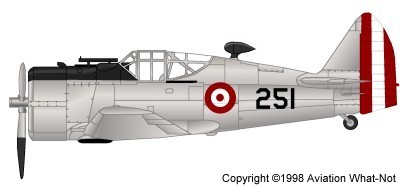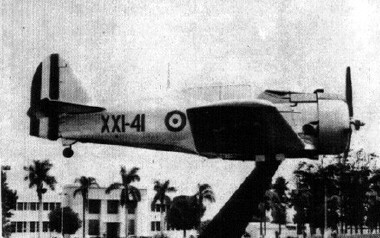This site is best
viewed at 800x600
and 16 bit color.
 |
| By Mario Overall and Kev Darling (Big Bird Aviation) With the collaboration of Ricardo Sanchez, Alberto Ñecco, Hjalmar Delaude, Jim Lyzun and Chris Banyai-Riepl |
The North American NA-50 (frequently and erroneously referred to as the model NA-50A) was a single seat, combat aircraft built expressly for ‘El Cuerpo de Aeronautica del Peru'. The machines were developments of the earlier NA-16-S trainer. Many of the changes developed by North American Aviation Inc., in the production of over 1,000 NA-16’s were subsequently incorporated to the new fighter. The result was an aircraft which was relatively easy to maintain under combat conditions . Allied to this was greater built-in strength for combat maneouvers and bomb shackles under the wings so that a useful load of over 100 lbs could be carried under the wings for ground attack missions. Possibly the most appreciated characteristics of the ‘Torito’ (Little Bull) as it was nicknamed by the lucky Peruvian pilots chosen to fly it ,was it comfortable and roomy cockpit,and excellent visibilty. Dimensions of the new fighter were given as, Span: 37ft 3ins, length: 27 ft. Weighing in at a gross weight of 6,800 lbs. The fitted powerplant for the NA-50’s was the Wright R-1820-G-3 nine cylinder radial engine rated at 840 hp. This gave the Torito a top speed of 295 mph at 9,500 ft, a respectable set of figures for a Latin American fighter of the period. Primary armament was a pair of 0.30 calibre machine guns synchronised to fire through the propeller arc. This is a suprising solution to the weaponry problem as wing mounted guns firing clear of the propeller were just coming to the fore as the preferred option in the 1930’s. At the begining of 1938 the CAP re-equipment programme was started and was to feature a range of aircraft types from various countries although the products of America were to figure prominently. Included in the new inventory were the forementioned NA-50’s for which a contract, No. FO53169, was issued by the Peruvian Goverment on 1 August 1938, for seven aircraft. Built with the constructors numbers 50-948 to 50-954 the seven fighters were completed by NAA at the begining of 1939. By February all had been shipped to Inglewood where test and acceptance flights were conducted . Delivery to the CAP was undertaken during March when all seven were shipped as cargo on a steamship bound for Peru.
* Arrival of the Toritos * The Toritos at war From 1931 to 1936,when the Treaty of Lima was signed, Ecuador had been provoking Peru with continued troop confrontations in the Peruvian Departmento (State) of Amazonas. Even after signing the Treaty, the provocations continued increasing in intensity between 1938 and 1940. CAP support for these operations was based initially at BA Teniente Coronel Ruiz de Chiclayo where the newly created Northern Air Group (Agrupamiento Aereo del Norte) was used to provide air cover for the Army’s operations . Bombing Squadron XI also known as the "Escuadron de Bombardeo XI" was rushed to alert, to provide the bombing element required . It operated alongside Escuadrillas 42 and 43 of Escuadron XXI. The NA-50’s were deployed to the airfield at Talara, where the pilots flew patrols in defence of the garrison located there. However on 5 July Teniente Comondante Antonio Alberti ,commander of the Escuadrilla ,received orders from the Chief of the Northern Air Group to transfer its aircraft to Tumbes where they were to provide close air support for ongoing ground operations. The transfer was completed by the next day; therefore the squadron was able to resume operations on 7 July. It was on this fateful day that Teniente Renan Elias, flying NA-50 XXI-41-2, returned to Tumbes with a bomb hung-up on one of the underwing mounts. At the suggestion of the airfield commander he flew the aircraft out to sea. Clear of the land he manouevered the fighter in an attempt to clear the bomb. Unfortunately for the pilot the bomb had become armed at some point and the violent shaking caused it to contact the wing and explode, killing the pilot and destroying the aircraft. The main thrust of the Peruvian Army operation was to recover the border posts close to Zaramilla and to repel further aggresive attacks from Ecuadorean forces against the advancing troops. In the early hours of the morning of 23 July the Army of Peru launched a major offensivefrom its base at Mata Palo, in the Tumbes Department, against opposing forces located at Zaramilla. So successful was this attack that they were able to capture Noblecilla Island along with the former Ecuadorian positions at Angulo,Rancho Grande, La Bomba , Salinas and Bejucal. These operations were overseen by aircraft of the Escuadrilla de Observacion Terreste (literally Ground Observation Squadron) No.70 whose job it was to provide running coverage of the fighting, while airborne in their Curtiss Falcon 22B’s. In conjunction with these prime objectives, the Peruvian Army also launched a major attack against the Ecuadorian primary troop concentration points at Quebrada Seca and Rancho Chico . Both of these objectives posed serious problems to the Peruvian air commanders as both areas were well protected by AAA batteries. At 07:30hrs on 23 July Teniente Comandante Alberti received the order to attack the Ecuadorian combat positions at both locations, using the aircraft of Escuadrilla 41 loaded with bombs and machine guns. By 07:50 hrs a section of the units NA-50’s was airborne, piloted by Teniente Comandante Alberti and Tenientes Fernando Parruad, Jose Quinones and Alferez Manuel Rivera, and departed Tumbes for Quebrada Seca. Arriving over the target they were subjected to intense anti-aircraft fire, however they pressed on with their attack against the machine gun nests that were holding up the army’s advance. Teniente Quinones' NA-50 was hit by gunfire from one of the AAA batteries after he had made an attack pass below 300metres (1000 ft) in order to destroy it. As he departed the fire zone the aircraft's damaged engine finally quit. With nowhere to go the pilot turned his ailing aircraft towards the battery that had shot at him. A few seconds later the NA-50 with its bombs still attached crashed into the trench, destroying the AAA battery while his astonished companions looked on in horror. A further witness,Teniente Garcia Romero, flying a Fairey Fox,72-1,in the ground support role also witnessed the event and later provided corroborative evidence. On that day Teniente Jose Quinones became the second hero of the CAP. At the cessation of hostilities he was postumously decorated for his gallant actions. The most important battle between these two nations took place at Zarumilla on 25 July. This eruption of violence subsequently became known as the Zarumilla - Maranon war. Such was the intensity of the fighting during the push forward by Peru that the Ecuadorian forces departed the field of battle in a rout. To stop the hostilities the United States intervened to separate the combatants and broker a cease fire. After the shooting had stopped, the Americans withdrew. This was the signal for the Peruvian Army to launch a lightning offensive in order to occupy strategic positions within the Southern Ecuadorian departamento of El Oro which covers an area of 200,000 square kilometres. In support of the ground forces the Peruvian Army employed Airborne Forces to occupy stretegic points. This was a first for South America. * Epilogue During their period at the Academy the aircraft were re-serialled 250 to 253 retaining these numbers when the CAP was replaced by the newly created Fuerza Aerea Peruana. Placed in storage the NA-50’s remained unused until 1954 when the Non-Commisioned Officers School requested that one complete flyable aircraft be created from the remainder. Being the best of the bunch, FAP-251 was restored to flying status by a team of dedicated mechanics . After re-commisioning, the NA-50 was at air displays and air force events until it was damaged in an accident in 1961.
That however is not the end of the story as FAP-251 was rebuilt to static display standard in 1965 and placed on a concrete pedestal at BA de Las Palmas as a lasting memorial to Teniente Jose Quinones.
|
| Sources : - Book "North American NA-16/AT-6/SNJ Texan" By Dan Hagedorn - Book "Historia Aeronautica del Peru" published by the Peruvian Air Force - Book "Air Forces of the World" By Green, W. - Magazine "Air International" v.36 #3 - Magazine "Small Air Forces Observer" v. 15 #3 |
